Over the weekend the City of Portland began their project to discourage people from driving on Southeast Clinton street and restore it as a true “neighborhood greenway” where bicycling is comfortable, safe, and prioritized.
There is now a new lane configuration on SE 34th (a north-south bikeway that feeds into Clinton), a semi-diverter at SE 32nd, and a full median diverter in place (but not finished) at SE 17th. After seeing reports about the diverters over the weekend, I rolled out this morning to get a closer look.
New bike lane and one-way configuration of Southeast 34th
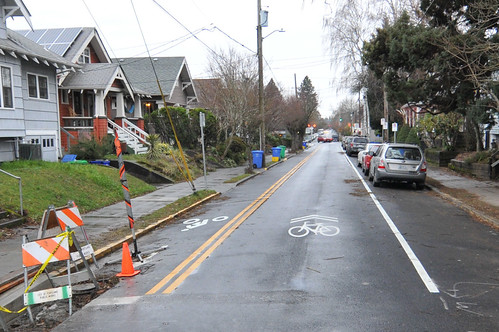
More than two years after 34th Avenue resident Mark Zahner began collecting signatures and support from the neighborhood, PBOT has made his dream come true. While the City balked at first, the rising tide of discontent about biking conditions on Clinton seem to have raised this boat as well.
34th is between Division and Clinton and it’s a key north-south bikeway connector to Clinton Street. The trouble was, it was so narrow — with on-street parking on both sides — that riding on it was a gauntlet and it was impossible for two people to drive down it simultaneously in opposite directions without havoc ensuing. PBOT has now fixed that issue by turning it into one-way only northbound (away from Clinton) for drivers and two-way for people riding bikes. There’s a bike lane in the southbound direction and a shared lane (with sharrows) in the northbound direction. PBOT heroically re-allocated space previously used to store people’s cars in order to make room for the bike-only lane.
I walked the road with Zahner this morning. “I’m thrilled. I love it!” he said. Zahner said the new configuration has made “everything move better” on the street.
But Zahner and other volunteer activists with BikeLoudPDX, the upstart group whose on-street actions and City Hall letter-writing campaign spurred this project, say there are still some big issues to resolve. Instead of taking the bike lane all the way to Division and preventing people from turning down the one-way street, PBOT decided to not start the bike lane or the “Wrong Way” signage until 50-60 feet south of Division. This means people are still turning south, then getting confused and awkwardly turning around or just barrelling illegally down the street anyway.
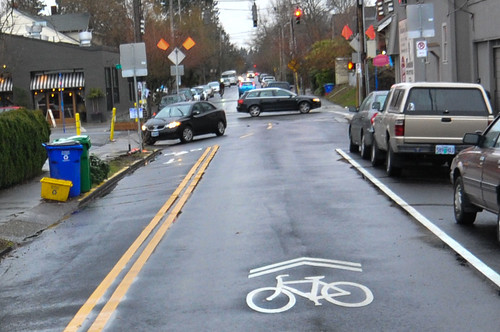
Why would PBOT do this? We’re still not sure, but it’s worth noting that a restaurant (Sen Yai Noodles) on the corner of Division and 34th (owned by non other than famed foodie Andy Ricker who you might recall from our parking story in November) has three new parking spaces accessible by a very long driveway on 34th. The bike lane begins where that driveway ends. Making matters worse, Zahner says delivery trucks park on the driveway and completely block the new bike lane.
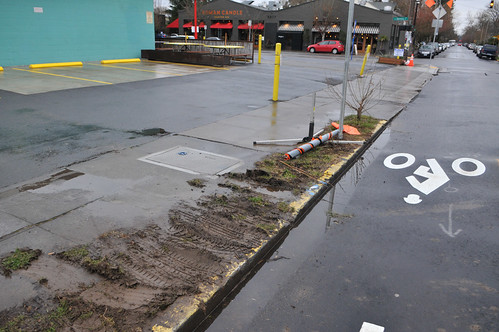
The good news is that PBOT is aware of these issues and they’re already working with activists to come up with a fix. Stay tuned.
Semi-diverter at SE 32nd
When I saw one local TV news station report “confusion” about the pair of semi-diverters installed at 32nd, I assumed it was just unfortunate framing. When I saw a second TV station also use the word “confusion” in their headline, I figured they might be onto something. Unfortunately, their headlines are warranted.
Any new traffic control design will take a while to get used to, but in this case PBOT has simply not deployed a very good design from the get-go.
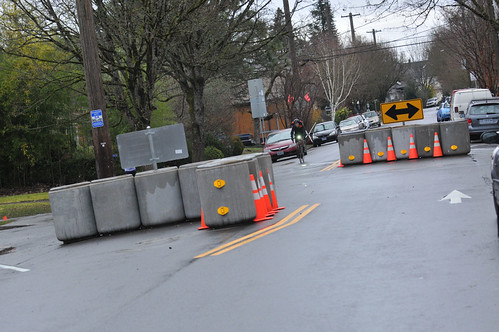
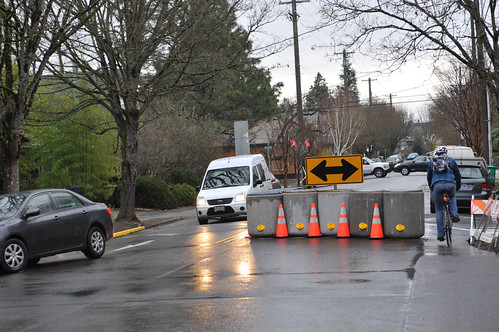
Advertisement
They’ve placed 10 large concrete drums (full of gravel) on each side of Clinton at 32nd. People driving eastbound are supposed to turn either right (south) or left (north). People driving westbound are supposed to either turn right (north) or left (south). People on bikes can continue straight through, and they’re supposed to stay to the right of the drums and pass through an opening on the curbside. The design in place right now however, does a very bad job of communicating proper behavior to both types of users.
Mark Zahner did an informal survey from 6:30 am to 9:00 am this morning. He marked down on paper what people did at the intersection. The results were not good:
- 78 percent of bicycle riders (226 out of 289) veered left and went into the opposite lane of travel to get around the diverters instead of staying curbside.
- 11 percent of automobile operators (15 out of 137) ignored “Do Not Enter” signs and drove around the diverters into the opposite lane of travel.
While I was out there, several people in cars drove around the diverters. Even people on bikes would ask, “Can I go through here?” And some of them even rolled up on the sidewalk just to be safe.
A Portland Police Officer showed up to monitor the situation and talk with a few of us on the corner. Even with her standing there and her car parked in plain sight, two people tried to drive illegally around the diverter. And to my happy amazement, Officer Pierce (I didn’t get her first name) jumped off the sidewalk into the street yelling, “Stop! Stop!” She made one guy put it in reverse while pointing at the “Do Not Enter” signs and yelling, “Didn’t you see the signs?!”. It was pretty awesome.

Officer Pierce who knew the issue well and was sympathetic to
safety concerns.
Why are people not doing the right thing? For auto users, the signage isn’t crystal clear, and since this is just a semi-diverter, there’s nothing to physically prevent them from simply sneaking around the diverter. And for bicycle users, the pass-through opening to the right (near the curb) isn’t nearly wide enough. There’s also an unrelated sidewalk project with barricades and torn up pavement that makes the pass-through even less inviting. Another issue with the bikeway pass-through design is that on-street parking begins too soon. PBOT has only removed one space, so as you look at the pass-through you see a rear car bumper and you have to make a sharp turn to avoid it. There needs to be a lot more breathing room for the bike movement.
There’s a general consensus among BikeLoudPDX that the current design is bad. In fact they’ve already scheduled a meeting to discuss it and make some recommendation to PBOT (Sunday, 4pm on 1/17 at Dots Cafe on Clinton).
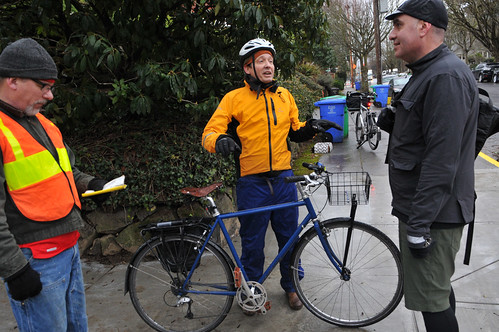
And PBOT is already well aware of the concerns. To their credit, project manager Rich Newlands was out there this morning talking to BikeLoudPDX volunteers. The fixes should be simple, but it’s a shame this design was ever left on the street. Even if this project is technically only temporary, first impressions matter and we deserve more well thought-out, safe, and intuitive street designs from the get-go. People should never be guinea pigs.
We look forward to reporting on some changes soon. PBOT said they’d re-assess the diverters this summer; but as activist Betsy Reese told me this morning: “There are some things that can’t wait six months.”
Median diverter at SE 17th
Crews were out this morning finishing up this one. This should work much better than 32nd because it will be a full diverter — meaning there will be a raised median island across all of Clinton forcing people to turn right. But unlike 32nd, these are just short little curbs that are easily rolled over by most cars.
While I was out there today, one of the PBOT work crew members recounted a story to Officer Pierce that an angry man yelled and threw things at them as he drove by this morning. And we just got an image (below) from reader Andrew K. who said a guy in a big truck plowed right over the still-wet concrete just as PBOT crews took a cover off of it…
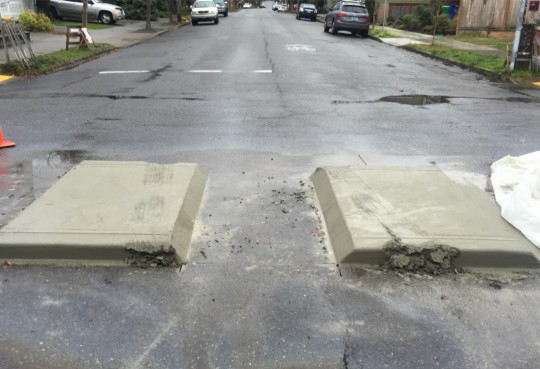
(Photo: Andrew K.)
Overall, it’s fantastic to finally see this happen. We’ve been covering the concerns about too many cars on Clinton for years now, and these diverters — once a few tweaks are ironed out — should help turn the street back into the neighborhood greenway it’s intended to be.
— Jonathan Maus, (503) 706-8804 – jonathan@bikeportland.org

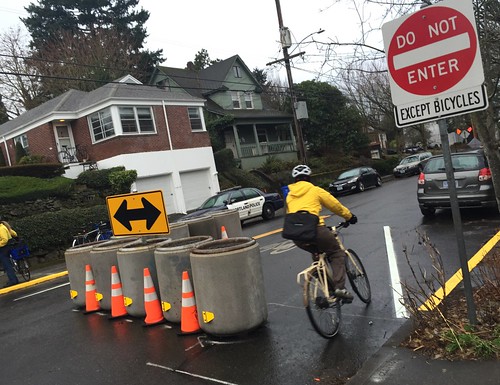

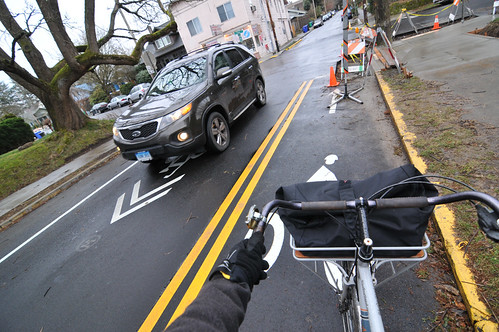
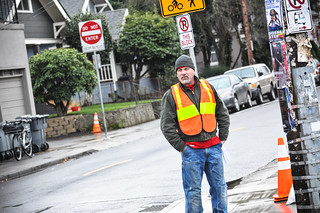
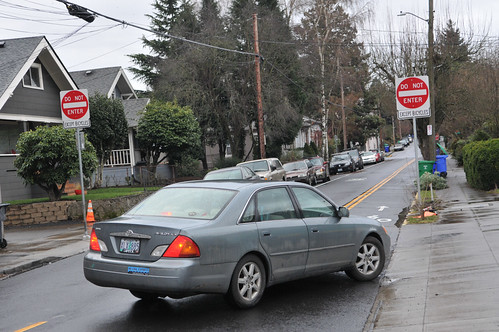
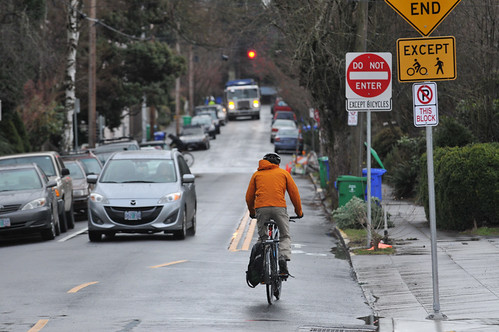
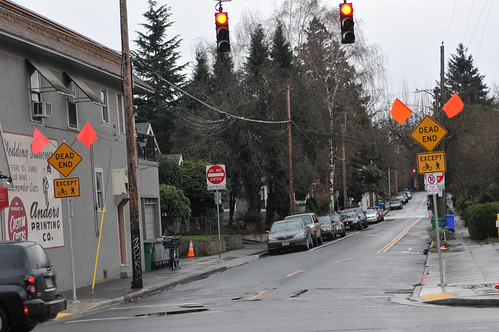
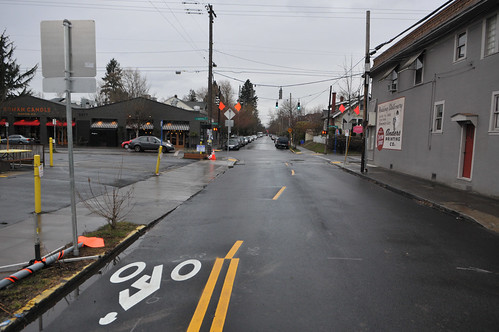
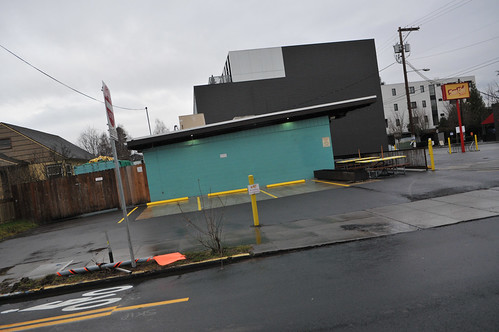

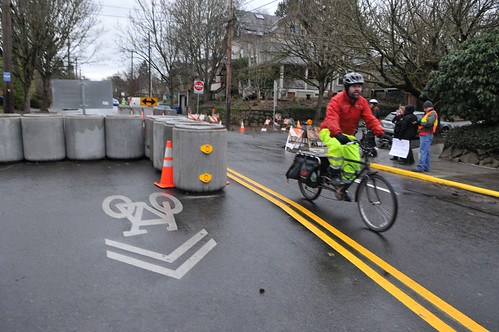
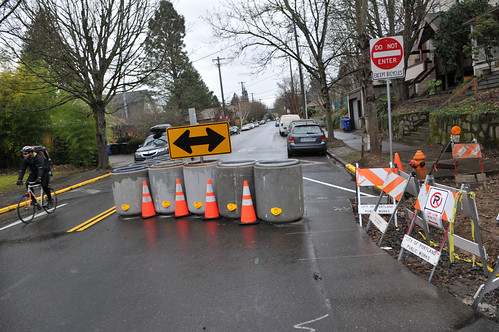
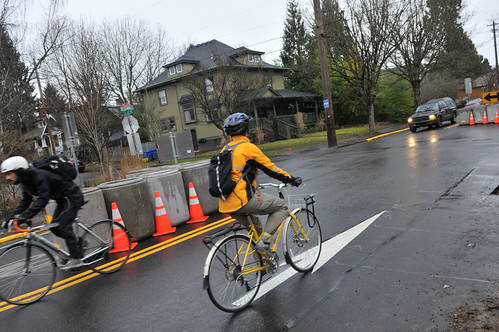
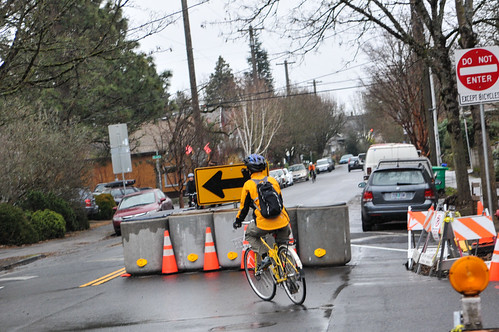


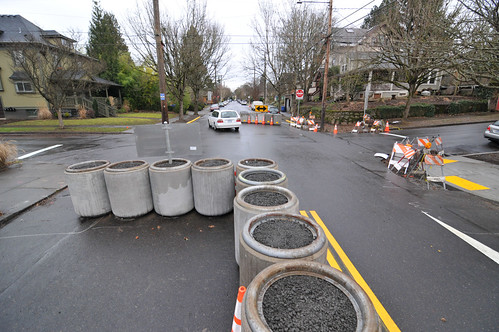
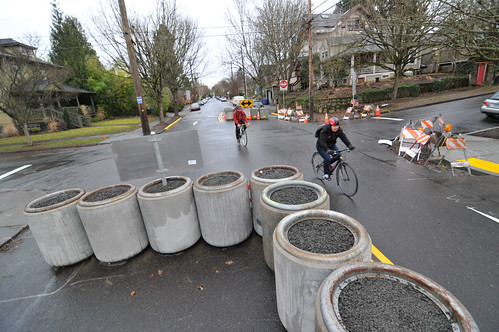
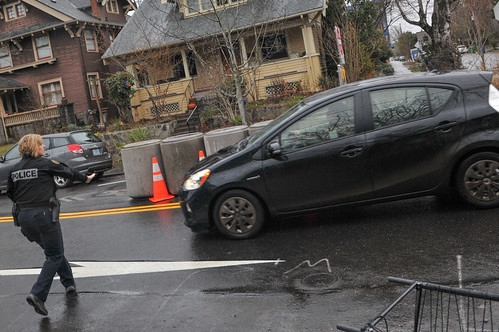
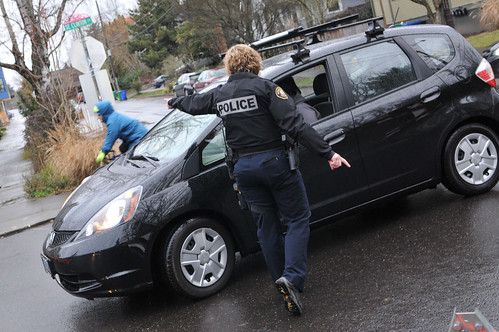
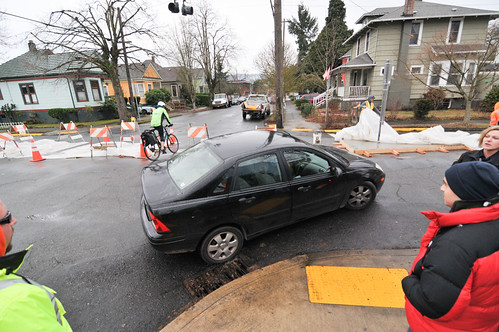
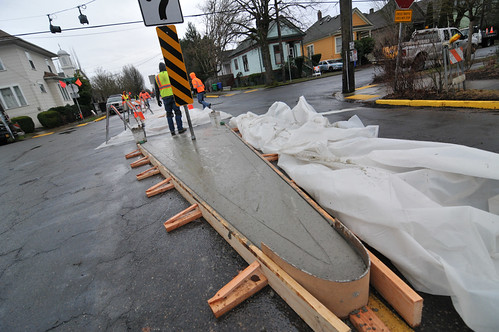
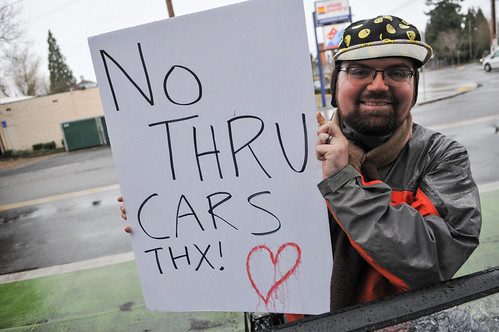



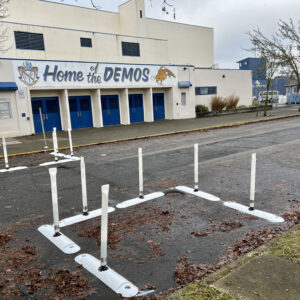
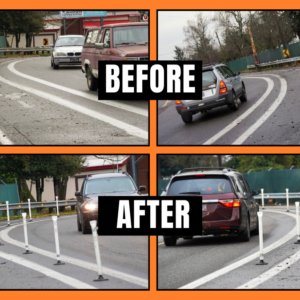
Thanks for reading.
BikePortland has served this community with independent community journalism since 2005. We rely on subscriptions from readers like you to survive. Your financial support is vital in keeping this valuable resource alive and well.
Please subscribe today to strengthen and expand our work.
They might consider a design like the one on Williams and Killingsworth. Still allows drivers to exit Williams if they live on the street.
Yes, this. The key thing about that one is there is a sign in the middle of the island that a car would have to drive over. (There used to be a tree there, too, but it got plowed over.)
ATB,
That would be a permanent diverter. These are temporary, test devices.
Is 17th & Clinton also a temporary device?
yes-ish. It is concrete poured on top of the AC and dowelled into it. 17th is less of a test than 32nd, but PBOT needed to consider all options.
It can be easily removed and the road patched, if needed, but would also last a long time, if needed.
Does “doweled in” mean a diverter-sized hole cut through the asphalt and filled with concrete? (I am pretty sure it does not mean held down dowels…)
Overall I think the design is pretty good (though wider openings might be nice for those with trailers), and thus unlikely to change, but I think most people would consider the implementation “permanent” in every meaningful sense.
Part of the sales pitch to neighbors was that it was a trial implementation, but anyone who saw how it was installed will not believe that’s what it is. This could raise some credibility issues down the road.
A dowel is a short circular object that mechanically connects to objects. Rebar. The street was only drilled with holes the rebar is grouted into.
I have photos that show this statement to be incorrect. There were large holes cut in the street surface to allow the concrete to be poured from the subsurface. Rebar was not used to fasten the concrete to the road surface.
Glad to finally see the diverters go in! Remember, PBOT is receptive to changes and tweaks, as this is intended to be a trial diverter. Often times, people here get labelled as “whiny” for complaining about new infrastructure, but even more so in this case, PBOT wants to hear your input. It’s okay to praise certain aspects of the diverters while simultaneously criticizing other parts.
Diverters which are porous to bicycles should be the preferred engineering standard in this type of application. They do it in Berkeley with just about 2 or 3 of those concrete cylinders spaced widely apart, letting folks on bikes flow both through and around them with no trouble and showing cars to find another way through. I don’t think they need all the extra structural reinforcements on this street….
They could take half of those barrels down to 17th, where apparently a small curb isn’t convincing everyone to turn.
Alan,
How would emergency responders get through?
Taggart or Division, I suppose. It would hardly be the largest discontinuity in the grid.
The concrete diverter at 17th is under construction. I believe it will have signs and delineators that should discourage people from driving over it.
Need some spike strips on the curbs. Also need some reversing strips like on the exits of some parking facilities like the Expo Center has. It would definitely cut down on wrong ways. Les Schwab would gladly sponsor them.
Tom,
How would emergency vehicles get through?
Speaking of Berkeley, they also do this:
https://www.google.com/maps/place/Berkeley,+CA/@37.8753127,-122.2780061,3a,90y,350.27h,53.63t/data=!3m7!1e1!3m5!1scedYytqGYhf0wMeb82aWvg!2e0!6s%2F%2Fgeo0.ggpht.com%2Fcbk%3Fpanoid%3DcedYytqGYhf0wMeb82aWvg%26output%3Dthumbnail%26cb_client%3Dsearch.TACTILE.gps%26thumb%3D2%26w%3D392%26h%3D106%26yaw%3D42.694359%26pitch%3D0!7i13312!8i6656!4m2!3m1!1s0x808579363a8549d3:0x94ea1595a675e993!6m1!1e1
I wonder why we don’t have this type of traffic diversion all over our neighborhood greenways – every 10 blocks or so make cars turn, thereby effectively limiting traffic to local traffic only.
yes, the diagonal diverter is the best design: cars have only one place to go, bikes and peds have a clear idea. This COP diverter on 32nd appears to allow cars to make both left and right turns, which seems to just add to the confusion and issue.
Did you attend any of the meetings? The design permits residents south of Clinton to keep their current access to Division.
they work… I hate driving through Berkeley residential areas…
Mostly,
Are you aware of the Neighborhood Greenway history or recent report?
As somebody who was pretty involved in bike boulevards in Berkeley, I have to say that these were my least favorite barriers to ride through. It’s easy enough to get to the opening in the barrier on a bike, but you have to make a tight-ish turn and cross a traffic lane (which doesn’t encourage cars to stop). It’s not that much of a problem as traffic is pretty low on those streets, but it’s not a solution that is very good to ride, IMHO.
I’m not seeing any reflectors on those big barrels. Am I just looking in the wrong place?
People driving big trucks over freshly-poured concrete barriers strike me as symptomatic of so much that’s wrong with Portland traffic – problems that simple changes like these diverters can’t address. Seems like an incredibly entitled mentality.
Having gotten those two things off my chest, I must say that this is still a big step in the right direction, and I’m pleased to see it.
How much entitlement is in a gallon of gasoline? Maybe letting it sell for $2-something or less per gallon has something to do with the overgrown toy trucks.
There are not enough reflectors and I was assured that this would be fixed.
I think there are plenty of reflectors for people who are biking and driving appropriately – appropriate speed and appropriate lighting.
If a motorist is driving too fast, it’s better that he/she crashes into a fixed barrier than a bicyclist. That will teach them.
Soren,
assured by whom? The intersection has a street light. The barrels have reflectors about a foot off the ground. The double arrow sign is quite reflective.
Rich stated he would request additional reflectors. Specifically, on the outward facing side of the barrels where there is only one small reflector per barrel.
his request was denied.
Paikiala, thanks for braving the comments section and for your efforts to help active transport flow safely and comfortably.
PBOT should send a bill to the guy that drove over the wet concrete. He should pay for the work needed to fix the curb he destroyed.
If this person can be found, (s)he should be charged under:
http://www.oregonlaws.org/ors/811.700
Maybe it was that fellow whose post was discussed here a few months back?
“I am a plumber. I need alerternate routes to get around bottlenecks. You’ve already messed up NE 50th at Burnside and Stark. NW Everett is a joke. Two lanes to one. Trimet buses stop traffic for blocks while a bike lane sits idle. North Williams is always a fun trip with no parking. Can’t wait for all the low bid fixtures to start failing in those cracker box apartments.
Seriously, you say there is not enough money for street maintenance? Stop the bicycle madness. Spend the limited funds on paving and forget about bikes. Until you make cyclist pay for licenses, pass safety tests, and wear a color other than black. There will be no support from hard working tradesmen, delivery drivers, working commuters aka taxpayers, for these projects”
http://bikeportland.org/2015/10/12/heres-portlanders-saying-clinton-diverters-words-165546
I’d love to compare taxes with this guy… for every dollar more that I pay, he has to bike to work one day while I get to ride wearing a black jersey. 😉
Would you compare overall taxes, or just gas taxes, which are really the better metric when it comes to road funding? If you lost, would you commit to driving over/through the new diverters once per dollar you fell short?
If we’re going to use gas taxes, then we have to factor in the relative damage of our vehicles, since so-called user fees only pay for about 45% of road construction and maintenance, the remainder coming from general taxes. The motorist would lose the proposed wager and do a lot of cycling.
Yeah, I’d guess they have to be normalized. I have two cars and a van, but I work from home and rarely drive and my primary car gets excellent mileage (plus I don’t drive it aggressively). I likely pay more in registration fees than Joe the Plumber (in two different states), but those don’t go to roads, they pay DMV employees to help educate drivers on keeping our roads safe…
I would Danny MacAskill those suckers in a kilt! 🙂
“PBOT should send a bill to the guy that drove over the wet concrete. He should pay for the work needed to fix the curb he destroyed. …” adam
I don’t see any warning barriers surrounding the fresh concrete that was damaged. Did city workers prematurely take them down, leaving someone driving to believe they could be driven over without damaging them? That would be the first thing to look into, before thinking to charge the person driving for damaging the fresh concrete.
True that people aren’t supposed to be driving over the barriers…cite them for that if it’s due…but don’t expect them to pay for damage to concrete they may not have known was too soft to drive over.
I see little reflectors at the base of the barrels. They don’t look to be large enough though.
The “do not enter” sign should be above the barrels. Drivers don’t know what yellow signs with arrows mean.
Well it kind of just looks like a “do not enter” sign for the section to the right which is basically a parking lane.
It blows my mind that this stuff isn’t more standardized.
It is, there is a thing called the MUTCD Manual for Uniform Traffic Control Devices, that explicitly shows and tells how and where to deploy traffic signage.
…and requires right side posting.
We suggested this to Rich Newlands this am. It’s important to note that construction and signage is not finished.
The sign has barricades nearly underneath it which create visual clutter. It’s a new situation, of course people are going to be confused.
Love the creative reuse of old TriMet trash barrels! Reminds me of the greatness which was once the transit mall in all it’s original 70s glory!
Also would make a great canvas for some creative painting.
Many thanks to PBOT for finally putting these much needed diverters in place. I am, however, incredibly concerned with the design. As mentioned, I would like to see them use the Berkeley design. Use half the pots and spread them out so that cyclists have multiple channels to pass through as opposed to one narrow strip. Can you imagine what that’s going to look like during peak bike commuter times? Yikes. Take the leftover pots and place them on top of the new diverters on 17th. Also, let the community paint these pots and plant flowers on top.
I believe the idea is to eventually have the final design look more like the semi-diverter at Chavez, with curb bumpouts. This is intended to be temporary. However, I do agree that a simple tweaking of the barrels positioning would greatly improve this diverter.
The curbs will need barrels/bollards or trucks will drive over them.
I agree it should allow more than one passage so two bikes can go through in parallel.
I’m sure someone will correct me if I’m wrong but I’m thinking the median diverter was specified so that emergency vehicles could get over it to get to fires quicker.
Sounds like we’ll need some hydraulic bollards.
Or just add some tire-shredding spikes on the raised part of the median. This can be DIY. Add one each time someone drives over until the problem goes away.
it would suck if an ambulance went over those spikes the wrong way.
Adam,
That is not what PBOT presented in the meetings. Islands like Williams at Killingsworth is the proposed final design.
Might be nice if BP included a simple map to help readers understand exactly where the interventions are located.
32nd Avenue. 17th Avenue. This is the Clinton project 😉
I wouldn’t say “There’s a general consensus among BikeLoudPDX that the current design is bad.” Rather, the general consensus is that there are some glaring errors in the implementation of the design that are easily fixable, but greatly impact usability and effectiveness of the diverter at 32nd as it currently stands. This sentence in the article makes it sound like we think the diverter overall is bad, and if that were the case we would have petitioned for a different design months ago. (Although I do think that having cyclists move to the right rather than the left as per the very similar diverter just 7 blocks to the east was an odd choice and could be considered a major design flaw.)
I’d say it works OK (only) for cars and is quite awkward to bike through. I bet no one really understood what it would feel like until it was on the road. There is certainly a general consensus that some tweaks are needed 🙂
‘major design flaw’ to build it like the diverters in Vancouver, BC?
Rode through those today, and that black car being pulled over was right behind me, lol.. Reading this, I think I also rode the ‘wrong direction’ around the diverter on 32nd, whoops. Although it’s certainly not the perfect setup (yet), it’s a great first step in the right direction- and we’re glad to see it!
Phase 2 could include a treatment around 26th. As an owner of a business in that area, perhaps you could contact PBOT showing your support? That would be a huge help! Thanks!
Not sure if this link will work, but it’s a video of a group ride yesterday. Looks like only one person took the legal route. I had a bike trailer so there was no way I would consider it at the 5ish mph I was going! https://www.facebook.com/jr98664/videos/10205233659856734/
We also turned off of Clinton at 17th, because of the narrow passage (for trailers because the concrete molds were still up)
I know this is an anomaly, and anecdotal, but interesting none the less for when Pedalpalooza comes around.
Yeah, that concrete passage doesn’t look too inviting for my trailer either. I’m not even certain it would fit and I wouldn’t want to find out while riding with a 500 pound load.
On the bright side, the concrete is clearly easily mountable with a motor vehicle. I’ll buy that as a best design when PBOT starts making travel lanes eighty inches wide.
It is a balance between ‘inviting for bikes’ and ‘not inviting for cars’ and ’emergency vehicle accessible’.
Also, a question I have is regarding the 4-way blinking light at 17th. It used to be a 4-way stop, but now only the north and south bound directions have stop signs (for cars). The blinking light will confuse some cyclists I’m sure.
Its still a 4 way stop
Except it’s not a 4-way stop anymore. Drivers will probably think it still is a 4-way stop (while the signage is clear, the presence of the big barrier suggests otherwise) Be extra aware in this intersection. Don’t assume that drivers will let you cruise through if they are stopped first. And, frankly, it’s tricky from a stopped car to see a bike coming towards the barrier from driver’s left.
yes, seems like a weird legal right-of-way issue there…
I assume those rectangular signs now on Clinton are “right turn only” signs where the Stop sign used to be…
so although you can now turn right without stopping you are still required to yield to people coming from the left stop sign because you usually don’t have the right of way approaching the dead end of a T intersection…
The flashing beacon at 17th is supposed to be removed.
how is a blinking red light confusing in the least? that’s pretty standard “STOP” signage…
The stop signs on Clinton have been removed.
Too bad they did such a horrible job indicating what cars and bikes should do at those diverters. Very inadequate planning.
Haven’t ridden Clinton, but I think a grid of bikes-only streets would be nice. I’d suggest a grid of residential streets about every 2 miles going N/S and same going E/W. Cars would have to be permitted to cross those streets but would be prevented from driving on them unless they lived there or were going to visit residents. The 2 mile number and which streets to include could be modified to suit realities on the ground. The down side would be that adjacent streets would see an increase in car traffic. Would not want to do it to streets with lots of businesses. AND the intersections would still be hazardous to cyclists – probaby best to have traffic lights at intersections.
I’ve done the design for you – now get the government to build it.
Lubbock, Texas goes one further. They have a street grid. Every nine blocks in one orientation and every fifteen in the other (IIRC) are major streets (seven lanes or more). The enclosed rectangles do not have any through streets for motor vehicles, but have lots of passages for bikes and pedestrians.
It works well. Unfortunately, being Texas no one actually rides or walks so the only real benefit is that people can live in neighborhoods that don’t have hosts of motorists speeding past their homes.
Seven lanes!! How’s that supposed to work for people who walk and bike? At some point they are going to have to get on or cross one (or eight) of those monsters to get where they are going.
“but have lots of passages for bikes and pedestrians.”
One of the many reasons Lubbock is a driving town. Ugh.
DS,
What would your ideal messages look like?
Both are not yet finished, BTW.
The NO THRU OR LEFT X BIKES signs at 17th have not been installed yet.
The NO TRU X BIKES signs at 32nd have not been installed yet.
The bike symbol and arrows at 32nd have not been installed yet.
From my saddle this morning…
My usual route links me up with Clinton at either 26th or 21st; this morning I went out of my way to use 41st northbound to Clinton in order to see the new diverters in action.
The intersection at 34th definitely needs improvement. I was among those who took the oncoming traffic lane without hesitation, because the path to the right looked inhospitable. I’m not surprised auto drivers are reacting poorly, as the signage is not immediately clear. I’m pretty sure we can do better than what’s been done there yet. Nevertheless I encountered no car traffic on Clinton after 34th until near 21st.
As I approached 21st continuing West, I heard a car approaching from behind. I stopped at the intersection then continued quickly; I tend to ride fairly fast on that stretch. Despite my speed (on the order of 20mph) I heard the crescendo of the engine as the driver began a pass but the maneuver was aborted in the face of oncoming Eastbound traffic. Once that was clear the engine roared again approaching 17th, but as we were near the stop the driver again aborted passing. I’m a strong-and-fearless type, but I was definitely aware that someone behind me was more interested in passing than in safety.
I went through the diverter and…no more roaring engine right behind me. It was quiet and peaceful. I’m very happy that diverter was put there.
Re: Semi-diverter at SE 32nd:
Yes it was very painful [as a project manager on other NTM projects] to watch the various TV news reports last night about the Semi-diverter at SE 32nd.
Other than the concerns already mentioned about the redesign the other crippling issue seems to be project coordination with the separate (?) sidewalk project. The sidewalk and curbing work should have happened first, as anyone in the field should have foreseen that narrowing the bike slot by ~2 feet for concrete curbing work and repaving would force most riders to ride around the other side (against traffic) with the new barriers in place.
Sadly, these types of design and implementation issues gives NTM (traffic calming and active transportation) a black eye if left too long.
PS. I am glad that PBoT is finally addressing the need for more effective traffic calming/ traffic management for such as important route…though it should have been done in phase (5 ? years ago).*
*[I was on one of the competing design teams for the redesign of the Clinton Bikeway, but the then ‘powers that be’ wanted a “softer” approach focusing heavier on the “art” component…vs. our team’s approach, as we were told.]
They don’t look like diverters. They look like things you can just easily drive around. Kind of like when you drive around a car that is parked in the road. We’ll see. I guess.
The arrows are especially confusing; it looks like they say “drive around”. The Do Not Enter signs look like “Don’t drive over here to the right” indicators.
If I were accustomed to driving on Clinton, and I saw this for the first time, I think I would think it was some sort of crazy speed control, and the thing to do would be to wait for an opening, then drive around.
I was also thinking the arrows on the ground at 32nd pointing straight are an indicator to continue straight, not to turn… and the Do Not Enter isn’t near the entrance so it doesn’t apply… I can easily see drivers justifying their actions going around those…
they need to replace the straight arrow with a double-turn arrow and signs indicating you can only turn… except bikes…
The arrows on the ground indicate that space only goes one direction. It is supplemental to the DO NOT ENTER signs.
The double arrow warning sign means the road you are approaching only goes left or right.
Dude with the flare on the road giving away donuts didn’t help the scene. Riding down Clinton this morning in the dark I see a flare, oh must be an accident, oh just a guy with donuts…oh crap concrete barrels in the road! There was another person on a bike turning around thinking the road is closed. My girlfriend started to turn around and I said it was just for cars and we promptly went to the LEFT of the diverter. Good times this morning.
apologies travis!
the flares were meant to warn people driving about the diverter. i got lots of positive comments from drivers and they got about half the donuts.
Thanks for replying and for helping out, it would have been helpful for the city to have some legit signage in place giving people a heads up. Cheers.
Sorry I don’t take anyone serious that complains about free donuts!
It would be interesting to see a follow up in a week to see how things are going.
Oh we will definitely be following up on this RH. You can count on that.
I was on the Tillamook Bikeway advisory committee in the 90’s and one of the reasons we put it on Tillamook was that wonderful diverter at 16th. It was put in by residents, and it makes a huge difference. Nevertheless Tillamook is subject to lots of auto “cheaters.” But the sky has not fallen in Irvington. Why not more of these style diverters on Greenways!? They are clear and offer straight forward directions to motorized vehicles.
First: look at the 2nd photo again of the one-way configuration on SE 34th.
Notice the trash containers on the left in the contraflow bike lane.
So I’m basing this on my limited (Aloha) knowledge of the Portland metro’s residential trash collection trucks but I suspect that they will have to drive this segment the wrong way to get residents trash.
Maybe the robotic trash can grabber arms can reach on both sides but I have a nasty feeling that they are designed for curbside collection on “normal” roads.
Luckily, the robotic arms are attached to a huamnoid device that is self-autonomous, and has the ability to bring bins from either side of the street if that is requested. Interestingly, I’ve seen these robots refueling from a small device marked “Starbucks”, which looks like it contains some exotic robot fuel.
We have pretty advanced tech up here in Portland proper.
Or you could just not be a smart arse and say it is done entirely by hand.
Nope, not possible.
See, I can respect honesty.
+1
🙂
Also: they are still physically getting out of their trucks to move garbage and recycling containers? Seriously?!?
Aside from the fact that I haven’t seen this style of garbage collection outside of movies in ages.
I assumed that the robotic hydraulic arm was a logical cost cutting response to workman’s comp lifting injuries and “mowed down by crazy American drivers” hazards.
In my neighborhood, trash is manually dumped into the trucks, old school. The recycling bins/yard debris are wheeled to the truck, then lifted and dumped mechanically. All the trucks seem to be fitted with noise amplification devices, and some appear to be powered by coal or burning tires. It’s actually pretty barbaric.
Google “pneumatic combined recycling trash system” and sigh wistfully.
Those are pretty slick… at least until some jackhole tries to cram an old mattress down the tube.
Q,
I looked at all the photos 3 times and saw nothing like you describe.
Really?
2nd photo from the top https://www.flickr.com/photos/bikeportland/24321001195/in/dateposted-public/
(automotive traffic is one way only going away from the camera’s point of view)
Notice that there are houses on the left side of the road.
Notice that the residents’ garbage cans are set out curbside for pickup.
Consider what happens if a garbage collection company is using a collection truck with a side grabbing robotic arm. This mode of operation seen here (https://www.youtube.com/watch?v=QxJzDubWJMQ) is very similar if not the same as what Aloha Garbage usrs and is the predominant trast collection truck used in the rest of the nation.
Because we drive on the right side of the road in America the safest curb to access is on the right and most trash collection trucks with side mounted robotic can grabber arms will only function with trash cans on the right side of the vehicle.
So if as (Hello, Kitty) states above the act of getting the garage can is still a human-gets-out-of-the-truck task my observation is irrelevant.
IF HOWEVER these right-side-only robotic trash trucks are being uses (or will be in the future) trash collection trucks will have to drive down this street unlawfully or residents will be forced to move their cans somewhere quite a bit less convenient and less safe.
Q,
I see. When you wrote ‘trash containers on the left *in* the contraflow lane’ you didn’t mean what you wrote.
Yep, honest verbal misrepresentation.
This doesn’t negate the potential problem with trash truck pickup.
Remove every other barrel. Paint them with retro reflective paint or attach large reflective panels. Adjust signage. Then see how it works.
If drivers insist on illegally and dangerously squeezing around the diverters, I hope PBOT has alternative designs ready. A Tillamook-style diagonal diverter, for instance.
I am curious, though, about the decision to use concrete barrels. Do they have drainage? Could some of the gravel be replaced with soil, so that neighborhood gardeners could plant greenery? As it stands, the diverters are, well, not the prettiest things.
i very much agree that the aesthetics are terrible but this is a *temporary* test diverter.
John – Rich reported to us that if made permanent, residents would be invited to plant vegetation in the barrels.
As it is, it’s a temporary project. If you want something to be permanent on installation, you might need to wait another 3 years for studies and all. We at BikeLoudPDX encouraged the city to put in a temporary diverter because it could be done more quickly.
Ted Buehler
Ah, I got it. Makes sense.
In Berkeley, many of the diverters have become rather nice little mini gardens. Our climate would be even better (rainfall).
John,
Are you familiar with the stories on this blog about people moving the planters on Multnomah?
Single planters are too light and can be easily moved by a disgruntled driver. It has already happened on the diagonal diverter on N Central at Tyler. PBOT tied these barrels together to reduce maintenance call outs.
Interesting… that makes sense. I stood at 32nd Ave for twenty minutes or so on Saturday afternoon and one of the neighbors mentioned that she’d like to move them… she then tried to lift one. Not surprisingly, it didn’t budge.
Jonathan wrote:
“There’s a general consensus among BikeLoudPDX that the current design is bad.”
and
“The fixes should be simple, but it’s a shame this design was ever left on the street.”
Um, I think the 32nd Diverter is pretty good. If not fabulous. Speaking for myself, not for BikeLoud. And while we all have some minor issues with it, I think we’re all absolutely delighted to see it in place. It was a beautiful evening tonight up at 34th, with mobs of bicyclists stopping to sign a “Thank you note” to City Hall, and hardly a car to be seen. A huge difference from the scene over the last couple years, with bicyclists cowering in the door zone as a stead stream of cars pushes through.
The only problem with the diverter design is temporary — that PBOT was replacing the curb on the north side, and didn’t have bicycle arrows directing bicycle traffic to the gap on the right. Perfectly understandablt that bicycle traffic might go on the left, since that’s what they’re required to do just 7 blocks east at Cesar Chavez.
I was out there tonight, the two new diverters are working well. They need a tweak or two, but we’re confident PBOT can tweak them in short order. It’s a good location, a good design, and a relatively quick execution.
Thanks PBOT!
Ted Buehler
I think the planter nearest the curb could be moved back to the triangle no parking area to better clarify bike through aspects.
That sounds like a clever fix to me! Will that make it too easy to move the disconnected one, though?
maybe.
Folks, PBOT pushed this project through pretty fast, and did two diverters and one contraflow bike lane. This is big for bicycling. It symbolizes the end of bicycle stagnation at City Hall.
If you like it, and want to see more protection for bicycle traffic on greenways, send a Thank you note to Steve Novick, Commissioner responsible for Transportation. Or, if you have other comments, be sure to let him know what you think.
Novick’s contact info:
novick@portlandoregon.gov
https://www.portlandoregon.gov/novick/
Ted Buehler
I’ll say this again:
Installing diverters on Clinton solves exactly zero automobile traffic problems, and likely will add to them on other streets. The unique bottleneck caused by Ladd’s Addition not being a grid and the rail lines going diagonal means that there can now be no relief from poor design on Division and Powell.
The answer is to offer alternative transportation options such as streetcars (conspicuously missing from SE) and actual bike routes, rather than what passes for a greenway in the US such as Clinton. Until ordinary people have real options other than private automobiles, the problems will only get worse. Diverters don’t add capacity for cyclists or any other mode.
Bike activists mean well, but are not doing the work selflessly. Portland is dotted with small victories from activists over the years, and I would prefer to see comprehensive policy changes over hyperlocal boondoggles.
“Installing diverters on Clinton solves exactly zero automobile traffic problems, ”
David — here’s my take on this issue —
I have met many people who are reluctant to travel by bicycle in inner SE Portland because they don’t feel safe on Clinton St. Many are mothers with children, some are parents not allowing their children to ride alone, some are folks that just don’t want to risk their life every morning.
Many people report that this is a change from the 1990 – 2012 era when Clinton St. was a very nice, safe and comfortable place to ride a bike.
People that aren’t biking because of unsafe conditions are…
Driving cars.
If we get a couple hundred people — adults biking to work downtown, teenagers biking to soccer practice or music lessons, moms and dads bringing their little kids to school by bike — it frees up space on Division and Powell for the remaining cars.
I’ve spent about 40 hours on Clinton between 26th and 34th in the last 16 months sitting at a table encouraging people to write postcards to the city, and talking to ordinary people riding bicycles and walking. This is what people have told me.
Do you think I am in error here? If so, can you explain?
Ted Buehler
pretty much. I passed the ridiculous diverter on 32nd last night and then was promptly buzzed by a female driver attempting to make the green light on 39th. 90 seconds later another female pulled right out in front of me on 42nd so close I could see inside her car with my bike light.
illusions of safety simply create false senses of security.
yes, it’s SUPPOSED to get worse for drivers… what else will motivate them to get out of their cars?
from my perspective drivers are causing their own congestion… they have options… there’s frequent bus service on Division… there are bike routes all over the place… drivers tore out the old streetcars in favor of traffic congestion… you reap what you sow…
I’d love to see a group of angry drivers petitioning the city for more transit… maybe you could get started on organizing that…
What will get them out of their cars is better options, not worse punishment.
Citation needed.
Manhattan has, perhaps, the best transit options in the country. Its streets are still gridlocked daily.
Usage fees and congestion itself are the only things that have been shown empirically to restrict SOV use.
My goal is a transportation system that works better for everyone, not one that is based on making one mode worse. It’s not a zero sum game.
I don’t know what sort of citation you want, but, driving inter-city in Europe is not at all bad (usually) and yet they also have excellent rail. Or (as I posted in the Columba Gorge story) getting to the Blue Mountains in Sydney is easy by car, but also easy by rail.
If you go out of your way to punish drivers in the hopes they’ll either become cyclists or lobby for better transit, you’ll end up a bunch of super aggressive and road ragey drivers for each person you’ve converted. That’s not the type of environment I want to ride in.
“My goal is a transportation system that works better for everyone, not one that is based on making one mode worse. It’s not a zero sum game.”
Unless you have Norway’s or Italy’s gas tax rate it is a zero sum game.
Perhaps you can explain why we can’t build better transit without making driving more painful. What’s the connection?
Gas taxes (at least in this country) are perceived to be a way to make driving more painful, especially if we actually were to jack up the rates so that serious money were raised. The way Europe got to where it is was largely to have been built up before the automobile. We don’t have that luxury.
As I’ve said here (and elsewhere) before, repeatedly, we should raise gas taxes significantly, but as a means to an end, not as a punitive measure. The difference is critical.
However, the success of mass transit does not depend on the money coming from a gas tax. It would work just as well if it were funded with income taxes, a sales tax, or buried treasure.
I am not sure why you have this hangup about the Pigovian dimension of the gas tax. Seems like splitting hairs to me.
Would you agree that of the top 369 transportation related things on your/my/our list, fewer cars, fewer VMT would advance every single one of those more than just about anything else you could think of?
No, I would not agree. My number 1 is reduction in GHG emission. Yes, reducing VMT would address that head-on, but even better would be to build out our electrical production/distribution/car supply to enable cheap, clean cars.
Increased mobility is an economic/societal good. The question is how can we best improve mobility while reducing costs. There are far more dimensions to this problem than more/less cars.
“No, I would not agree. My number 1 is reduction in GHG emission. Yes, reducing VMT would address that head-on, but even better would be to build out our electrical production/distribution/car supply to enable cheap, clean cars.”
The one you dismiss though is less speculative than your preferred alternative. There is as yet no such thing as cheap, clean cars, and even if there were it wouldn’t solve the 368 other problems with cars unrelated to how clean they are.
“Increased mobility is an economic/societal good. The question is how can we best improve mobility while reducing costs.”
Do you mean access? Mobility to my mind is not a societal good, but access is. The latter can be provided by far more strategies than the former, and at lower cost. Universal mobility can be a collective disaster. Universal access not so much.
“There are far more dimensions to this problem than more/less cars.”
Of course there are and I never said otherwise. But we were talking about gas taxes, and the two chief ways they operate. You have consistently objected here in the comments to the Pigovian tactic and I was asking why.
I simply object to the concept of making life difficult for people as an end in itself. Perhaps that’s just a philosophical difference between us. I don’t think I can explain it better than that. I think intentions matter when setting policy.
It is interesting that you find the idea of Americans giving up driving as less speculative than technological advancement. Perhaps that’s just another philosophical difference. When I see the first presidential candidate running on a platform of “Give up your cars!” perhaps I’ll reconsider.
“It is interesting that you find the idea of Americans giving up driving as less speculative than technological advancement.”
We were talking about reducing VMT by taxing gasoline heavily. That I think is not speculative. In fact we were sort of in the middle of that when the Saudis decided to go for broke and keep pumping the black stuff into the world market.
As for making life difficult for people… I guess it depends on which people we’re concerned with. For a hundred years we’ve made it increasingly difficult for anyone not in a car. Time for a correction.
But seriously, life is all about tradeoffs. And as Monsieur Penalosa said ‘you can have a vibrant city or you can make things swell for cars but not both,’ or words to that effect.
I thought we were talking about the idea that it is necessary to tear one mode down to build another up. There are always tradeoffs, of course, but I don’t think of transportation as a zero-sum game. We can run more frequent trains without adding speed bumps to I-84.
The quote I was specifically responding to was: “yes, it’s SUPPOSED to get worse for drivers… what else will motivate them to get out of their cars?”
Which I reject.
O.K., point taken. Hard to keep track of the nuances here when we run out of reply space 🙂
I agree with you that it isn’t a priori necessary to tear one down, zero sum, etc. But in the case of the automobile would you agree that historically this is pretty much exactly what happened, not just because of demand but also by design? The ascendance of the car proceeded on the ashes of all other options at least in the US?
Now to undo this I’m having a hard time envisioning how to both continue to fund, subsidize, build out car infrastructure and hope to make any headway with alternatives. The money isn’t there. Nor is the motivation. And the economics are all screwed up too.
I agree it is what happened, by design, but mostly because of demand driving that design. If people didn’t want to drive, didn’t think it was better than the available options, the design would have been different. (And yes, I know the story about GM and the streetcars.)
Regardless, we are stuck with the outcome now. People are starting to see the tradeoffs might not have been such a good deal, which is why in many cities, the inner cores are booming.
I’m not sure how we undo the last 50+ years of development, or if we can. It will basically mean rebuilding all our cities, which just doesn’t seem plausible. I just don’t see a viable solution.
HK,
“I cannot give you the formula for success, but I can give you the formula for failure – which is: Try to please everybody.” – Herbert Bayard Swope
Yes, so true. But that does not negate my statement. There may well be times where you need to remove an auto lane, for example, to make room for a bus. But that is very different than removing an auto lane in order to make driving so slow that people choose to take a bus instead.
The users for which the transportation system, for too long, has been designed to please are the ones whom future changes will not please.
We agree!
You are assuming 1) a static population with a static list of wants/needs, and 2) a static palette of transportation options. I assume neither.
How so? I’m not following.
Different options, different people at different stages in their lives, a different generation… maybe what people want is changing. Maybe people who once saw cars as their only options now see their needs differently. Maybe technological change will bring options to the table. Or, maybe paikiala is right, and people who liked the way cities were built will not welcome further change. It’s hard to predict.
Until driving sucks we won’t get reasonable alternatives.
Trying to provide enough capacity to make driving not suck is a losing proposition. This has been proven over and over again with highway widening projects.
Removing auto capacity prompts people to take fewer car trips and make alternate choices (without changing the total amount of congestion). This has been proven over and over again with freeway removal projects.
If we can force commuter SOVs onto the arterials, this will push some drivers past their congestion-tolerance points, and the driving demand will decrease to meet the reduced supply.
Car users often complain about congestion and “bad drivers” and I actually think these are good things. Because they mean we aren’t widening the roads and making things even more car friendly, like, say, Phoenix.
Can you imagine the hell hole Portland would be if there were the same number of cars and no congestion?
I know a few car commuters in Portland who converted to bikes, Bolt bus, and Max because they were tired of congestion and bad drivers. Step in the right direction.
“and actual bike routes”
Neighborhood greenways are not actual bike routes? What is an actual bike route?
“such as streetcars (conspicuously missing from SE)”
Portland’s 2nd street car line runs through the SE.
Bike activists mean well, but are not doing the work selflessly.
Why do you presume to speak for all “bike activists”? I’m also curious to learn what you believe are my selfish motivations for bicycle advocacy.
“Actual bike routes” probably means separated bike trails, like the Springwater.
“Streetcars…” probably means that our streetcar network is a pathetic shadow of what it once was (though I would argue that buses more than pick up the slack)
“…selfishly…” might refer to comments suggesting that a goal of bike advocacy is to make driving more difficult.
To be clear, I don’t agree with the original post, but that’s how I interpreted it.
It’s a pity that David does these drive by criticisms and does not respond…
I personally believe that bicycle advocacy helps decrease congestion and helps makes driving easier.
I casually read Bike Portland, and comment when I feel I have something to offer. I lived for many years in Europe when I was in the military and I have a perspective I think few others share. I love cycling at least as much as anyone reading this, but I do not care for most bike culture in the US, because it is tribal, Portland especially so.
Not selfless isn’t the same thing as selfish, and in hindsight I should have used a term like non-altruistic. Where are the non-bicycle-riding bike activists?
If you look at my IG, you’ll see that I posted a photo from the Hollywood MAX station, on the night of the 10-year party at Velo Cult. It shows an image of the Portland light rail map, which completely avoids SE Portland altogether. Why? That could go so far to reducing automobile use, while making cycling safer for lack of cars.
People drive into the city because they have to, which is a shame. People who drive through Portland on I5 may want nothing to do with Portland, but the geniuses who knocked down half the buildings in this town to put up a freeway force them to share the interstate with commuters just crossing town. So as a consequence a lot of drivers are frustrated and late to their appointments!
But where are the activists on these issues? Good transportation policy includes all modes, and politicians and bureaucrats who don’t understand that should be replaced. That’s how things change.
Sorry I misinterpreted your words. But there is now a new light rail line running through SE Portland, and a Bus Rapid Transit line under development along Division and Powell (though I am highly skeptical if the plan will offer any real improvement over current non-rapid bus transit).
So maybe our planners aren’t quite as incompetent as you fear?
If you think the Orange Line runs through SE Portland, you need a new map.
Where does it run?
@hellokitty For some reason your post lacked a reply button, so I’m replying to my own comment.
It runs directly to Milwaukie, which is why it exists. There are a few stops in Portland and I’m sure folks that live near them that need to go downtown appreciate it, however that’s the extent of its usefulness.
I don’t think the Orange Line is exceptional, for the same reason that I don’t think that a line that should be on Barbur (but isn’t) would be exceptional, and that a line that should be on Burnside (but isn’t) would be exceptional, and that a line that should be on Sandy (but isn’t) would be exceptional, and Powell, and so on. That fact that they don’t exist is [a word that will flag my post], brought to you by decades of politicians and city leadership that prefer to install speed bumps and celebrate victory. Where’s my party hat?
[After a certain level of nesting, the reply button goes away.]
I’m sure the folks in Brooklyn both find the line useful, and feel they are in SE Portland.
I mostly agree with your criticism that the Max doesn’t go everywhere it should (I used to totally agree, now am less sure), but buses do the job in most respects. It would be hard to make the case that SE Portland is underserved by buses.
I have an extra party hat… you can have it.
It’s good to see the debate this has generated; thanks for stating your views. I agree with you on these points, but I am also guilty as charged for taking the “hyperlocal” tactic: where I live, our best successes have been when we focus on individual problem areas, propose viable solutions, and exert tremendous persistence until they are fully addressed. As far as sweeping policy change goes, I can only dream of the day when enough people where I live now care about fixing the status quo on our roads to stage a “die in” at our local transportation authority HQ!
Both approaches are necessary. One can identify and fix specific infrastructure problems like the ones that killed Jeff Donnelly in Palo Alto or Martin Greenaugh in Portland. The more ideological (and political) approach you seem to be advocating is what MADD used to reduce DUI deaths, has allowed women to vote, minorities to achieve civil rights, and the gay lifestyle to become more (gradually) integrated into American laws and policies – not that all examples are without exceptions still. As you know, bicycling is a far more integrated and socially accepted form of transportation in Europe, but that still has a long way to go in the US – we are a country with many examples of individual bicyclists getting tickets for riding legally while drivers break laws on a mass scale with impunity. Yes, part of that change is advocating for alternatives to personal car use (besides just bikes) while still allowing it for those who truly need it – when they need it.
Lastly, traffic diverters are not meant to advance the cause of bicyclists, nor are they meant to reduce automobile traffic. They’re used as a stop-gap solution where cars have been shown to repeatedly threaten the safety of people. I was reminded of this yesterday as I rode by two different tracts here in silicon valley that had diverters added to stop cut-through traffic; on the other side of one was a makeshift basketball hoop where kids were playing by the side of the road (like I was able to do as a child in the formerly small town where I grew up). Bicyclists were not why these two sets of diverters were installed here, nor many of the other examples you can find all over America.
It will unfortunately not be a zero sum game as long as cities encourage population and business growth and continue to enable more and more people to drive (at increasing speeds).
“It will unfortunately not be a zero sum game as long as cities encourage population and business growth and continue to enable more and more people to drive (at increasing speeds).”
Hear, hear.
Ditto on this. Not only do the added diverters solve no auto traffic problems, they solve no bike commute “problems,” which is to say they don’t change my bike commute in any way, shape or form. Anyone who has not and does not feel safe on Clinton should probably just not be on a bike on nearly any half used road in the city. That fraction of the riders can go carefully on the sidewalk when they feel the need. Or walk! Or take public transportation, as might be the rallying call to drivers! Let’s get a perspective.
And btw, there has been that small portion of riders feeling unsafe since before 2012, the point being again, there will always be that super minority. Some people don’t feel safe driving their car. Shall we build a special track for them?
Furthermore, I have been both bike and car commuting from 52nd St, near where I live, westward and eastward for 25 years, using Powell, Clinton and Division. Clinton has always been an important artery designed for cars to move through the neighborhood in a way intended, arguably and among other reasons, to reduce the burden on larger arteries, especially Div. and Powell during rush hour. As David refers to, the jumbly Orange Line interchange removed a vital inter-neighborhood outlet from Clinton to Ross Is. Bridge, forcing an even greater burden onto Powell and Division. I do not feel guilty for using Clinton as a backup route, to the greatest extent possible, from the nightmares on those other streets, as well as their accessing intersections (think 50th/52nd and Div. at rush hour, pre hundreds more apartment units, 50/52nd and Powell with removed lanes, etc). Of course, now one is forced off the larger Clinton artery and onto smaller neighborhood roads.
Ted, regarding “If we get a couple hundred people — adults biking to work downtown, teenagers biking to soccer practice or music lessons, moms and dads bringing their little kids to school by bike — it frees up space on Division and Powell for the remaining cars.”
Those are lofty and worthy aspirations, but like much of the pro density mantra, is simply not realistic to any significant degree. Attracting to the city heaps of progressive bike-riding environmentalist or whoever and whatever generality one wishes to use (and I count myself among them), mainly means more congestion due to all their cars and bodies.
Sitting on Clinton St. talking to the passersby is singing to the choir, which is likely largely lacking in breadth and depth of experience here.
Mine is a very valid perspective, seemingly ultra conservative and out of touch, mostly to those who have a self entitled and narrow perspective or interest. Yes, I generalize.
One final observation, from yesterday’s bike commute, reflecting a bit of this attitude, was one of those stubborn middle-of-the-roaders with an average sized yellow trailer behind. He had cars and bikers slogging behind even upon coming into a very clear opening on Woodward (which isn’t even the Clinton “greenway”). I went ahead via the sidewalk and watched as he rode past, and suggested he might move a little to the right so traffic could get around. He basically screamed “NO! a couple times. Clearly he as a complex about this matter. I do believe bikers are generally expected to move out of the way when reasonable, but the ballyhooing and lobbying on Clinton St. has indeed made many bikers think they have free reign, and that cars are evil. That guy sort of reminded me of Ammon Bundy and LaVoy Finnicum.
This is a great idea. According to David Hembrow primary cycle routes should be no more than 750 Metres apart. This is just under half a mile. Fitting into Portland’s street grid, that would be from 7 to 10 blocks apart.
Vancouver’s cycle routes vary in how far apart they are. I notice that cycling is higher and more a normal part of life in the places where they are closer so having more of them in an area makes a difference.
“Cars would have to be permitted to cross those streets but would be prevented from driving on them unless they lived there or were going to visit residents.”
Great imagination, but how is this scenario even achievable, technically or fiscally?
This is great to see it starting. This is the time to take lots of notes and give the city lots of feedback so they know what’s working and what isn’t and why. (Also lots of praise for doing this.)
The road rage being exhibited by motorists is increasing daily.
Just the other day I saw a motorist flashing his lights angrily at the motorist ahead of him simply because the motorist in front was slowing to make a right turn. There was absolutely nothing in the front motorist’s behavior or actions that was questionable. The trailing motorist was upset by someone else inconveniencing him.
Driving over a just completed curb and driving across the planting strip and curb are indications of how bad things are getting.
The minimum levels enforcement, low fines, and absence of meaningful penalties will allow this behavior to increase.
Who’s bright idea was it to block half the bike lanes with sidewalk construction? Couldn’t the diverters been pushed back slightly to allow for a better install with fewer issues?
Or, perhaps they could have fixed the sidewalks on Clinton while they were doing the sidewalks on Division. Either way, not very much forethought went into this, even with the ~7 months of delay already.
When the left hand tells the right that the curb work will be done by the end of December, the right had believes them.
The barrels closest to the curb are planned to be shifted, maybe tonight.
Well, the “right hand” said that the diverters would be in place last summer. And you sure seem to know a lot about PBOT. Do you work for them?
I am employed by PBOT. I work for the citizens of Portland (all of them).
What does it matter?
It only takes fives minutes to witness a car circumvent the diverters on 17th, I just watched someone turn right, pull a u-turn 20 feet past the diverter and turn right again to continue down Clinton. PPB needs to enforce the diverter immediately, unannounced, with no warnings.
I’ve seen that as well. Are U-turns on 17th illegal? How about using a driveway to turn around, as some have reported? I’m not sure what we’re seeing is actually illegal. According to this site, mid-block U-turns are illegal in Oregon, but if done at an intersection they are OK. So I guess the specifics are important.
http://animatedtrafficlaw.org/atlc/2013/05/14/u-turns-oregon-v-california/
I suppose it depends on your interpretation of the law, as well as the officer/judge interpretation of the law. To me it falls under 811.365(1)(b)
http://www.oregonlaws.org/ors/811.365
This looks consistent with what I posted. If they proceed to the next intersection, the U-Turn is fine. This might rule out using a driveway.
Incidentally, the prohibition of mid-block U-Turns on residential streets is so widely disregarded that I would be shocked if you could find anyone willing to enforce it (or even acknowledge it was prohibited) unless it was done in a particularly dangerous manner.
The behavior – using a driveway to turn around, while obnoxious, is not illegal.
That’s what I was thinking, until I read the statue. It seems very much less clear to me now.
Would a 3-point turn be legal?
It’s not a U turn.
Are you sure?
“A person commits the offense of making an illegal U-turn if the person is operating a vehicle and the person turns the vehicle so as to proceed in the opposite direction…”
It sounds like this could be read to include both 3-pt turns, and “driveway turns” (which are just an inglorious 3-pt turn). And it kind of makes sense… the difference between a U-turn and a 3-pt turn is mostly one of vehicle capability and skill.
Vaguely written law is tested by what the ‘common man on the street’ would decide. A U-turn, by definition, is to change directions in a single movement.
At any rate, about half of the people u-turning and driveway-turning are also blowing the stop signs, so you could easily cite them for failure to obey a traffic control device.
same goes for the cyclists I’ve seen blowing the red light at the same intersection the past 2 nights.
The stop signs at 17th on Clinton have been removed.
That’s why the diverter needs to extend further either direction. Ideally forcsay half a block.
Poorly implemented and designed “infrastructure” from the City of Portland is not surprising. In fact, it seems to be the design standard.
I’m still not clear why the existing center islands, already in place on Clinton, weren’t retro fitted with diverter spokes instead of these messes and why these locations were selected in favor of the more effective island locations.
Did you attend any of the meetings?
Unfortunately, no.
I’ve heard the reasoning from those who were in attendance. But, honestly it sounds apologetic, considering the ultimate goal is removal of cut through auto traffic and better bikability. The way it stands now, this just creates a situation where cut through motorists either travel one or two more blocks on arterials before cutting into Clinton, or as I saw yesterday, they drive around/over the barriers and continue. Maybe I’m missing something…Care to enlighten me?
PBOT meetings: 1) a welcome place for your creative ideas when there is no money to be spent; 2) a place to share with the public nearly fully baked plans when everyone’s design mind is already made up, but only to see if there are any really loud objections and if the evening news will pick it up due to unsavory business impacts regarding delivery and parking, etc.
One man’s ‘nearly fully baked’ is another man’s ‘fiscally and prudent viable alternatives’.
Glad to see something happening here, but this is just the tip of iceberg of traffic calming needed throughout Portland’s neighborhoods.
PBOT has not done drastic diversion on a regular basis for many years. This is also different from the usual process in that the diverters are internal to a project, not just out at the major crossings. It is pretty easy to justify diverters at major crossings – there are adopted standards for crossing safety that support access management.
Blocking local streets internal to the collector grid is a new area of access management, a step up from just managing speed, and no policy to do so existed in Portland until last year.
Help PBOT figure out what works best for Portland. Stay involved on Clinton and get involved when it becomes Tillamook’s, Lincoln’s, and Alameda’s turn.
I came through 32nd and Division (westbound) a few hours ago, and the arrangement of the diverter blocks had been adjusted to make the bike lane on the right of the diverter much wider (the rightmost diverter block had been moved back behind the line of blocks). So it seems the city corrected the design error very quickly.
There isn’t usually all that much car traffic on Clinton at noon, so it is hard to judge, but it did seem a little lighter today.
At 17th, I wonder if the blinking light on Clinton will eventually be switched to a yellow caution light rather than a red stop light. Now that bikes are the only through traffic on Clinton, it doesn’t seem like it needs to be a four-way stop anymore.
Awful awful awful. All three instances are design disasters causing only confusion and anxiety. Im both a bike and car commuter and I would have no idea how to navigate these areas. This is what Portland residents are paying for??
I can’t speak for the 34th diverter, which I haven’t seen, but I think you would have no problems navigating the one at 17th. First off, you probably wouldn’t find yourself on Clinton. Second, where to drive is obvious. Third, most people who do happen upon this will know the neighborhood and will figure out pretty quickly how to change their route to avoid the diverters in the future.
For someone like you, it really won’t be a problem.
I’ve ridden through them twice now. 17th is easy, straight forward, stop look and go. the 34th diverter is a ridiculous nightmare for anyone riding over 8mph.
Wow. Yes, those concrete tubes might actually work. Looks like PBOT has learned valuable lessons from the plastic bollards!
More attractive permanent barriers can be seen in Irvington, in the form of extended curbs + planted medians with trees and sidewalks.
$$$$
A sign stating “roads closed to cars” might have been useful.
Clinton has signs approaching 32nd that say NOT A THROUGH ROAD, and approaching 17th is not yet complete, but will have the same.
your words in quotes are not factually true. neither 17th, nor 32nd is closed to cars, so driving on Clinton is also not closed.
“There needs to be a lot more breathing room for the bike movement.”
That says it all, Jonathan.
How can I request a police presence on E Ankeny from 6th to 12th? 30 year old white guy in a truck revved his engine as I headed down ankeny and followed me aggressively after turning behind me. Almost hit an oncoming car as he passed me just before Nong’s. I’ve had repeated problems on the stretch, especially from cars that try to cross ankeny without looking up the hill.
823-SAFE, or safe@portland.gov
The police need a specific time of day for a recurring issue so they can target enforcement. Random bullies would be difficult to catch.
PBOT needs a bike rider enforcement action that targets people driving.
Yes they do. Something different than the bullshit they did on Clinton.
I’ll let someone else censor that out… I can’t bring myself to do it.
correction
safe@portlandoregon.gov
As a member of the neighborhood I have no problem with the divider at 17th it’s only a mild inconvenience, but removing the stop sign at 17th seems dangerous. I understand the intention of not wanting cyclists to have to lose momentum (I get it I hate stops when I ride), but with the flashing lights most cars still haven’t caught on to the radical change in traffic pattern and assume it’s still a four-way (especially if they only ever take 17th and never Clinton). Add to that the fact that 17th used to be the safe place in the neighborhood to cross the greenway. Now no matter where they cross no matter how safe they’re trying to be neighbors have to contend with cyclists riding their fastest, on a dark road, not looking out for cross traffic, with parallel parked cars and trees obstructing their view.
It would, I imagine, work much like the intersections at 16th and 18th… neither better nor worse.
The flashing lights were being modified this am.
I have to say that when I drove N on 17th today, the “cross traffic does not stop” signs caught me completely by surprise. It’s tough when the big barrier sends your unconscious brain the signal that *nothing* is going through that intersection in an east-west direction on Clinton, but the signs say the opposite.
I think removing those signs is a unsafe decision, and I say that as somebody who thinks the diverter was a fine idea. I can easily imagine plenty of bike-friendly drivers (like me) following their intuition rather than the signage, and I want to urge anybody going through the diverter to *not* assume that traffic on 17th will stop for you if they get to the intersection first and assume it’s still a 4-way stop…like the equivalent situation at 20th and Harrison.
I was entertained watching a smart car squeeze through the diveters at 17th earlier this evening. I think the diverters are great despite the small amount of confusion.
From my experience, whenever something new like this happens there’s a period of time where aggressive drivers go to the place and intimidate people biking. This dies down after a few weeks though.
Overall this is great. Once the new equilibrium of the area settles down you’ll find this so much nicer to ride down and the people living there will find it nicer to live there.
I came on here to say the exact same thing!! The last couple days have been crazy, with cars (many, not talking bad apples) going all cannonball run to get around the obstacles. Can’t wait for the honeymoon to end on this one.
I’m not really surprised, because that’s what it looks like you’re supposed to do.
Yes, I know there’s the Do Not Enter signs, but because the configuration is so unusual, and you never see those signs in the middle of a street like that, and because you can physically drive through, I think there are just too many conflicting signals, people get confused, and they go with what they see as the least unlikely explanation.
It probably doesn’t help that they might have driven the route many times before (prior to installation of the diverter), and they have a desire to get somewhere on the other side (which might color their judgement).
All in all, I think this will continue to occur, especially if there are no consequences of driving through the diverter.